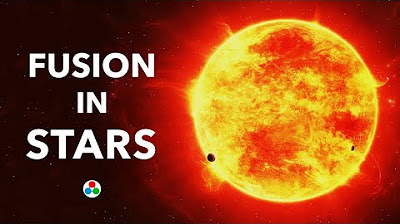Nuclear Fusion | Fusion energy explained with Hydrogen atom example | Physics animation video
Summary
TLDRThis video explores nuclear fusion, a process where lighter nuclei combine to form heavier ones, releasing massive energy. It explains the fusion of hydrogen nuclei to create helium, illustrating the energy release through mass loss calculation. Despite the potential, controlling such reactions for practical use remains a challenge, highlighting the complexity of harnessing nuclear fusion for energy production.
Takeaways
- 🔬 Nuclear fusion is a process where two or more nuclei combine to form a heavier nucleus, releasing a large amount of energy.
- 📚 The term 'nuclear' refers to the nucleus, and 'fusion' implies the merging of entities to form a single entity.
- 🌟 The process involves lighter nuclei like lithium and helium combining to form heavier nuclei, such as helium-4.
- 🔢 The conservation of energy is satisfied as the mass of the resulting nucleus is less than the sum of the initial nuclei, with the difference being released as energy.
- ⚖️ The mass loss during the fusion of four hydrogen nuclei to form helium-4 is 0.297 AMU, which corresponds to a significant energy release.
- ⚡ The energy released from the fusion of four protons is calculated to be 27.6 Mega electron volts, demonstrating the power of nuclear fusion.
- 🌐 Despite the potential for vast energy release, controlling the process is challenging, which is why there are no full-time nuclear reactors for fusion built yet.
- 💡 The script explains the nuclear fusion process using the example of hydrogen nuclei combining to form helium, a process that occurs in stars like our sun.
- 🔬 The script provides a scientific definition of nuclear fusion as a nuclear reaction involving the combination of lighter nuclei to form heavier ones with energy release.
- 📈 The script emphasizes the importance of understanding the mass-energy equivalence principle in nuclear fusion, as explained by Einstein's famous equation E=mc^2.
Q & A
What is nuclear fusion?
-Nuclear fusion is a nuclear reaction in which lighter nuclei combine together to form heavier product nuclei, releasing enormous amounts of energy in the process.
What is the significance of the word 'nuclear' in the context of nuclear fusion?
-The word 'nuclear' in the context of nuclear fusion refers to the process involving the nucleus of atoms, where nucleons merge or fuse together.
How is the term 'fusion' defined in the context of nuclear fusion?
-In the context of nuclear fusion, 'fusion' refers to the process where two or more entities, such as atomic nuclei, come together or merge to form a single entity.
What is an example of a nuclear fusion reaction?
-An example of a nuclear fusion reaction is the combination of lighter nuclei like hydrogen to form a heavier nucleus such as helium, accompanied by the release of a significant amount of energy.
Why is the mass of the heavier nucleus less than the initial reacting nuclei in a nuclear fusion reaction?
-The mass of the heavier nucleus is less than the initial reacting nuclei because some of the mass is converted into energy during the fusion process, as described by Einstein's mass-energy equivalence principle, E=mc^2.
How is the conservation of energy satisfied in a nuclear fusion reaction?
-The conservation of energy is satisfied in a nuclear fusion reaction because the mass deficit, which is the difference in mass between the reactants and products, is converted into energy, as per the mass-energy equivalence principle.
What is the chemical equation for the fusion of four hydrogen nuclei to form helium?
-The chemical equation for the fusion of four hydrogen nuclei to form helium is 4 H -> He + 2e^+ + 2ν, where e^+ represents positrons and ν represents neutrinos.
What is the significance of the energy release in a nuclear fusion reaction?
-The energy release in a nuclear fusion reaction is significant because it is enormous compared to other reactions, making it a potential source of clean and abundant energy.
How is the loss of mass in a nuclear fusion reaction calculated?
-The loss of mass in a nuclear fusion reaction is calculated by subtracting the final mass of the product nucleus from the initial combined mass of the reactant nuclei.
Why are there no full-time nuclear reactors built for fusion reactions despite the substantial energy release?
-There are no full-time nuclear reactors built for fusion reactions because controlling the enormous energy release and achieving a sustained, stable fusion reaction is technically challenging.
What is the role of the positron and neutrino in the nuclear fusion process described in the script?
-In the nuclear fusion process described, the positron and neutrino are byproducts of the reaction. They are emitted when a hydrogen nucleus combines with another to form deuterium, which is part of the overall fusion process leading to helium formation.
Outlines

このセクションは有料ユーザー限定です。 アクセスするには、アップグレードをお願いします。
今すぐアップグレードMindmap

このセクションは有料ユーザー限定です。 アクセスするには、アップグレードをお願いします。
今すぐアップグレードKeywords

このセクションは有料ユーザー限定です。 アクセスするには、アップグレードをお願いします。
今すぐアップグレードHighlights

このセクションは有料ユーザー限定です。 アクセスするには、アップグレードをお願いします。
今すぐアップグレードTranscripts

このセクションは有料ユーザー限定です。 アクセスするには、アップグレードをお願いします。
今すぐアップグレード関連動画をさらに表示

Bersinar milyaran tahun, dari mana asal energi matahari?

How Stars Turn MATTER into ENERGY | Nuclear Fusion

21.4 Nuclear Fission and Fusion

Nuclear Fusion Explained

IPA FISIKA : Reaksi Nuklir Fisi dan Fusi (Pembelahan dan Penggabungan Inti Atom)

Nuclear Fission v Nuclear Fusion: Differences and Similarities Explained
5.0 / 5 (0 votes)
